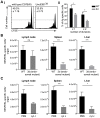Dendritic cells and hepatocytes use distinct pathways to process protective antigen from plasmodium in vivo
- PMID: 21445239
- PMCID: PMC3060173
- DOI: 10.1371/journal.ppat.1001318
Dendritic cells and hepatocytes use distinct pathways to process protective antigen from plasmodium in vivo
Abstract
Malaria-protective CD8+ T cells specific for the circumsporozoite (CS) protein are primed by dendritic cells (DCs) after sporozoite injection by infected mosquitoes. The primed cells then eliminate parasite liver stages after recognizing the CS epitopes presented by hepatocytes. To define the in vivo processing of CS by DCs and hepatocytes, we generated parasites carrying a mutant CS protein containing the H-2K(b) epitope SIINFEKL, and evaluated the T cell response using transgenic and mutant mice. We determined that in both DCs and hepatocytes CS epitopes must reach the cytosol and use the TAP transporters to access the ER. Furthermore, we used endosomal mutant (3d) and cytochrome c treated mice to address the role of cross-presentation in the priming and effector phases of the T cell response. We determined that in DCs, CS is cross-presented via endosomes while, conversely, in hepatocytes protein must be secreted directly into the cytosol. This suggests that the main targets of protective CD8+ T cells are parasite proteins exported to the hepatocyte cytosol. Surprisingly, however, secretion of the CS protein into hepatocytes was not dependent upon parasite-export (Pexel/VTS) motifs in this protein. Together, these results indicate that the presentation of epitopes to CD8+ T cells follows distinct pathways in DCs when the immune response is induced and in hepatocytes during the effector phase.
Conflict of interest statement
The authors have declared that no competing interests exist.
Figures






Similar articles
-
CSP--a model for in vivo presentation of Plasmodium berghei sporozoite antigens by hepatocytes.PLoS One. 2012;7(12):e51875. doi: 10.1371/journal.pone.0051875. Epub 2012 Dec 18. PLoS One. 2012. PMID: 23272182 Free PMC article.
-
Antigen export during liver infection of the malaria parasite augments protective immunity.mBio. 2014 Jul 29;5(4):e01321-14. doi: 10.1128/mBio.01321-14. mBio. 2014. PMID: 25073641 Free PMC article.
-
Processing of the circumsporozoite protein in infected hepatocytes is not dependent on aspartic proteases.Parasite Immunol. 2008 Jun-Jul;30(6-7):375-8. doi: 10.1111/j.1365-3024.2008.01032.x. Epub 2008 Apr 27. Parasite Immunol. 2008. PMID: 18444957
-
Protective CD8 T cells against Plasmodium liver stages: immunobiology of an 'unnatural' immune response.Immunol Rev. 2008 Oct;225:272-83. doi: 10.1111/j.1600-065X.2008.00671.x. Immunol Rev. 2008. PMID: 18837788 Free PMC article. Review.
-
Induction and maintenance of protective CD8+ T cells against malaria liver stages: implications for vaccine development.Mem Inst Oswaldo Cruz. 2011 Aug;106 Suppl 1(0 1):172-8. doi: 10.1590/s0074-02762011000900022. Mem Inst Oswaldo Cruz. 2011. PMID: 21881772 Free PMC article. Review.
Cited by
-
From the draining lymph node to the liver: the induction and effector mechanisms of malaria-specific CD8+ T cells.Semin Immunopathol. 2015 May;37(3):211-20. doi: 10.1007/s00281-015-0479-3. Epub 2015 Apr 28. Semin Immunopathol. 2015. PMID: 25917387 Free PMC article. Review.
-
CSP ubiquitylation favours Plasmodium berghei survival during early liver stage infection.Sci Rep. 2025 Apr 25;15(1):14498. doi: 10.1038/s41598-025-98294-4. Sci Rep. 2025. PMID: 40281042 Free PMC article.
-
Flp/FRT-mediated disruption of ptex150 and exp2 in Plasmodium falciparum sporozoites inhibits liver-stage development.Proc Natl Acad Sci U S A. 2024 Jul 9;121(28):e2403442121. doi: 10.1073/pnas.2403442121. Epub 2024 Jul 5. Proc Natl Acad Sci U S A. 2024. PMID: 38968107 Free PMC article.
-
Systemic toll-like receptor ligation and selective killing of dendritic cell subsets fail to dissect priming pathways for anti-vaccinia virus CD8⁺ T cells.J Virol. 2013 Nov;87(22):11978-86. doi: 10.1128/JVI.01835-13. Epub 2013 Aug 28. J Virol. 2013. PMID: 23986587 Free PMC article.
-
Varying Immunizations With Plasmodium Radiation-Attenuated Sporozoites Alter Tissue-Specific CD8+ T Cell Dynamics.Front Immunol. 2018 May 28;9:1137. doi: 10.3389/fimmu.2018.01137. eCollection 2018. Front Immunol. 2018. PMID: 29892289 Free PMC article.
References
-
- Nussenzweig RS, Vanderberg J, Most H, Orton C. Protective immunity produced by the injection of x-irradiated sporozoites of plasmodium berghei. Nature. 1967;216:160–162. - PubMed
-
- Romero P, Maryanski JL, Corradin G, Nussenzweig RS, Nussenzweig V, et al. Cloned cytotoxic T cells recognize an epitope in the circumsporozoite protein and protect against malaria. Nature. 1989;341:323–326. - PubMed
-
- Schofield L, Villaquiran J, Ferreira A, Schellekens H, Nussenzweig R, et al. Gamma interferon, CD8+ T cells and antibodies required for immunity to malaria sporozoites. Nature. 1987;330:664–666. - PubMed
-
- Chakravarty S, Cockburn IA, Kuk S, Overstreet MG, Sacci JB, et al. CD8+ T lymphocytes protective against malaria liver stages are primed in skin-draining lymph nodes. Nat Med. 2007;13:1035–1041. - PubMed
Publication types
MeSH terms
Substances
Grants and funding
LinkOut - more resources
Full Text Sources
Other Literature Sources
Medical
Research Materials
Miscellaneous

